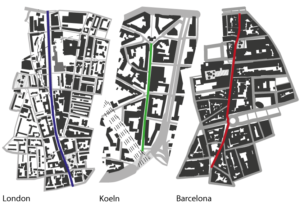 << Mapping >>
<< Mapping >>
Knowing how to ‘map’ a multisensory environments is crucial for researching sensory regimes and understanding the way in which power relations are structured sensorialy in cities. This leads to two considerations:
a) how do we map and capture the fluid and ephemeral nature of the sensory, and
b) how do we represent the ways in which they relate to power?
 i. Across senses:
i. Across senses:
Sensing is multi-modal. While it is useful to focus on individual senses and understand how each sense frames our access to the world, it is important to think about firstly how senses interact and thereby create a sensory ecology; secondly, how is this sensory ecology shaped by hierarchies and power relations.
There are lots of different methodological approaches on how to map the senses, have a look at our summary of the methods developed during our Sensory Cities workshops.
- Workshop summaries
- Look at the individual Cities/Streets
> Link to talks/literature:
Most of our academic talks would be useful to watch, here are some examples:
Alex Rhys-Taylor (sociologist and deputy director of the Centre for Urban and Community Research, Goldsmiths, University of London)
Fried Chicken and Flat Whites: Olfactory Agents of Demographic Change
Sandra Kurfürst (University of Cologne)
Semiotics of urban space: producing and negotiating meaning in the city
Lars Frers (University College of Southeast Norway)
Confronting absence: Relation and difference in sensual engagements with the lived city
Reading suggestions:
Rhys-Taylor, Alex. 2017. Food and Multiculture: A Sensory Ethnography of East London. London: Bloomsbury. ISBN 9781472581181, http://research.gold.ac.uk/19300/
 ii. Across time:
ii. Across time:
Especially when analysing urban environments the senses need to be studied across time, both from a historical perspective but also in terms of temporal variations of day/night; weekday/weekend; workdays/holidays. A historical approach aids to understand how sensory interpretations and hierarchies change over centuries. A deeper understanding of how particular histories inform sensing and sense making are needed. So far despite the rich research on urban and sensory history – empirical studies on sensory urban histories remain far and few between.
> Methods:
Example: Barcelona workshop - Research and Representation for Museum Curators
Recording Power Relations through Sound: A group of museum curators, sound artist and sociologist explore the soundscapes of el Raval in Barcelona. This group recorded sounds in different areas of el Raval focusing on thresholds to analyse how power-relations might be framed within ephemeral moments of public life.
Physical thresholds implied dramatic changes in soundscape, switching from noisy to quiet environments (lo-fi vs. hi-fi), allowing us to appreciate sounds and acoustics of different spaces; crossing thresholds also conveyed differences in light, temperature and tactile experiences. The concept of thresholds allowed us to investigate the interfaces of public spaces as articulated by streets, courtyards, squares and alleyways. It offered us the opportunity to heighten our awareness of the different qualities of public space embodied in sensorial experience.
> Links to talks/literature:
Dr Monica Degen (Sociologist, Brunel University)
Why El Raval?
Dr Astrid Swenson (Historian, Brunel University)
In the Shadow of the Cathedral: writing sensory histories
Joan Roca (Director of the Barcelona’s City History Museum)
Displaying Urban History: Lessons Learned
Eusebius Wirdeier (Photographer)
Fotografische Arbeit am Eigelstein/Photographic work on Eigelstein



